When a fast-growing SaaS brand approached us for performance marketing support, their customer acquisition funnel was suffering from rising costs and inconsistent lead quality. They partnered with Storme Digital to revamp their growth channels and turn paid search into a high-performing revenue driver.
The outcome? A 230% increase in Monthly Recurring Revenue (MRR) within six months, fueled by precision-targeted Google Ads, intelligent keyword scaling, and cohesive SEO-PPC alignment.
In this detailed case study, we unpack the exact strategies that transformed underperforming campaigns into a scalable engine of client acquisition.

1. The Challenge: Traffic without Traction
The SaaS brand had active Google Ads campaigns but struggled to maintain lead consistency. Their cost-per-lead was rising, while conversion rates continued to decline month after month.
Website sessions were increasing, but high bounce rates and minimal demo bookings painted a clear picture: the traffic was unqualified and uninspired.
Our team conducted a full-funnel audit. The core issues we uncovered included weak ad copy, poor keyword targeting, and a generic landing page with no compelling value proposition.
2. Setting the Goalposts: MRR or Bust
Together with the client, we defined two aggressive 30-day objectives:
- Reduce cost-per-lead by 40%
- Increase qualified demo bookings by 60%
The broader 6-month target? Increase Monthly Recurring Revenue (MRR) by at least 200%. Every decision, optimization, and strategy were reverse engineered from this north star.
3. Keyword Intelligence: Say No to Vanity Metrics
Our first tactical move was a deep semantic audit. We categorized keywords by buyer intent, funnel stage, and ROI history. Branded and competitor keywords were isolated. Low-intent search terms that burned ad budget were culled.
We added high-converting long-tails aligned with pain-point searches, including phrases like “best CRM for sales teams” and “automate onboarding for SaaS.” This boosted relevance scores, improved Quality Scores, and dropped CPC by 29% in the first 15 days.
4. Landing Page Optimization: UX That Converts
Next, we overhauled the landing page using proven CRO principles. A new headline and subheadline hierarchy was introduced, anchored in transformation language rather than features.
We introduced credibility indicators such as testimonials, real-world application examples, and a streamlined form placed prominently for faster lead capture. Page speed was improved by 38%, resulting in a 56% increase in demo requests and a longer dwell time.
5. Campaign Structure Overhaul: No More Wasted Ad Spend
We rebuilt the Google Ads campaign structure from scratch. Each ad group was themed tightly by intent cluster. We leveraged responsive search ads with dynamic keyword insertion and A/B tested multiple copy variants.
Geo-targeting, dayparting, and device-level optimizations helped us narrow in on the highest-converting audience segments. This led to a 74% lift in click-through rate (CTR) and halved the average CPL by day 30. Our approach followed best practices outlined in our Pay-per-click services in Gurugram framework.

6. SEO & PPC Alignment: The Long Game Begins
We did not stop at paid clicks. To ensure compounding results, we ran parallel SEO sprints focused on the same core keywords used in ads. Blog content, optimized help articles, and improved metadata ensured organic lift complemented paid efforts.
By month three, the site began ranking for over 180 new keywords organically, reducing paid dependency without sacrificing conversions. A shared reporting dashboard integrated SEO + PPC KPIs to align the marketing and sales teams around revenue, not vanity metrics.
7. Takeaway Insights: What Moved the Needle
Several strategies made the biggest impact:
- Removing keywords with minimal purchase intent helped optimize budget efficiency and improve lead quality.
- Systematic ad variation testing revealed high-performing messages in a shorter time frame.
- High-performance landing pages lifted conversions without increasing ad spend.
These growth tactics were further validated through A/B tests and multivariate analysis. Explore our offerings to dive deeper into optimizing PPC efficiency.
8. Bonus Strategy: Intent-Based Retargeting
We implemented a retargeting campaign with segmented creatives based on user behavior. Visitors who viewed pricing but did not convert were shown testimonial-driven ads. Those who bounced early were retargeted with feature highlights and value-based messaging.
This lifted retargeting ROI by 142% and re-engaged leads that otherwise slipped through. Discover more tips on how to design retargeting flows that drive results.

9. The Result: From Paid Clicks to Recurring Clients
The transformation was not linear, but it was dramatic:
- 230% growth in Monthly Recurring Revenue (MRR) in six months
- 52% drop in CPL
- 81% increase in demo requests
But most importantly, the SaaS company built a scalable engine of growth—one that aligned marketing, sales, and product value.
Conclusion : Strategy Wins Over Spend
Growth is not about pouring more money into ads. It is about investing in precision. Every successful campaign starts with clarity—on who you serve, how you solve, and what triggers conversion.
If your ad spend is not turning into revenue, it is time for a smarter strategy.Book a free marketing call with our team today and start your journey from clicks to clients.
